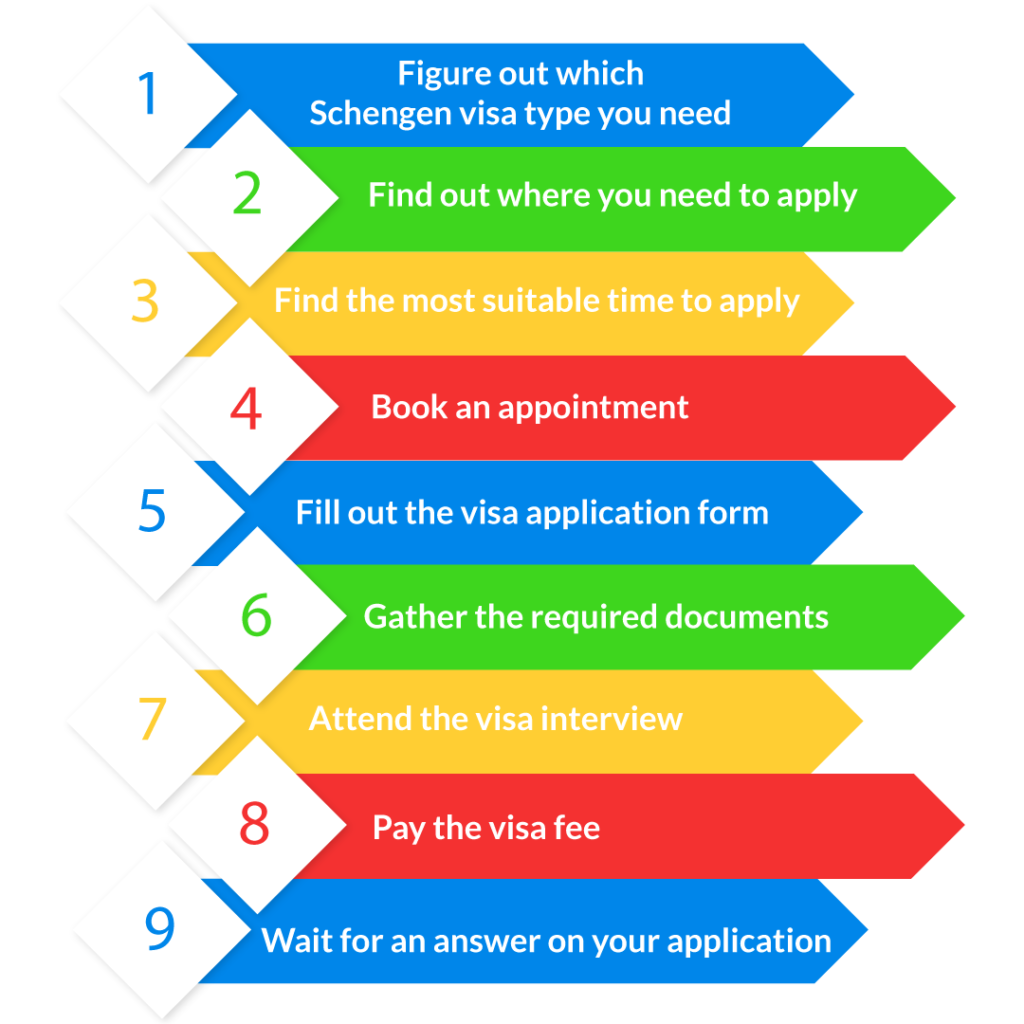






Previous
Next
SUBSCRIBE HERE
Sign up for latest news about Portugal immigration!
Services
Schengen- Student Visa
Schengen- Business Visa
Citizenship for Sephardic Jews
Golden Visa- Investor
Schengen Area
Preview Only
Who needs Schengen Visa?
While there are categories and nationals of countries that are privileged with entering the Schengen visa-free zone, there are also other categories and nationals, which have to go through all the process of meeting requirements and attending interviews, in order to obtain a visa that grants them with the permission to enter the Schengen Area.
Citizens of Which Countries Need a Schengen Visa to go to Europe?
The countries whose citizens are required to obtain a Schengen visa in order to enter any member country of the Schengen Area are:
[table id=1 /]
Citizens of Which Countries Need an Airport Transit Schengen Visa?
There are countries citizens of which need also an airport transit visa in order to change the airplane at an airport in a Schengen Area country.
The list of the countries which are subject to the airport transit visa in the Schengen Area goes as following:
- Afghanistan
- Bangladesh
- Congo (Drc)
- Eritrea
- Ethiopia
- Ghana
- Iran
- Iraq
- Nigeria
- Pakistan
- Somalia
- Sri Lanka
There are however exceptions regarding the Airport Transit Visa for certain individuals. In case of the following terms, the nationals of the above mentioned countries are not obliged to obtain an airport transit visa:
- If the person holds a residency permit from a Schengen member country, a valid Schengen Visa for short stays or long stays.
- If the person holds a residency permit from countries such as, Andorra, Canada, Japan, San Marino or the USA that guarantees the persons whereabouts.
- If the person holds a valid Schengen visa or a valid visa for entering one of the EFTA countries as well as Canada, Japan or the United States, even if they are returning from those certain countries after using this visa.
- If the person is a family member of e EU citizen (close family only)
- If the person holds a diplomatic passport.
Citizens of Which Countries Don’t Need a Schengen Visa to enter Europe?
1) The countries whose citizens are not required to obtain a Schengen visa in order to enter any member country of the Schengen Area for tourism or business purposes are:
[table id=5 /]
* Visa-free regime applies to citizens of Albania, Bosnia and Herzegovina, Macedonia, Moldova, Montenegro and Serbia only if they are holders of biometric passports.
** Visa-free regime applies to holders of passports issued by Taiwan only if their passport contains an identity card number.
2) Special administrative regions of the Peolple’s Republic of China:
- Hong Kong***
- Macao***
*** Visa-free regime applies only to holders of a “Hong Kong Special Administrative Region” passport.
*** Visa-free regime applies only to holders of a “Região Administrativa Especial de Macau” passport.
3) British citizens who are not nationals of the United Kingdom (British Nationals (Overseas):
- British Nationals (Overseas)
- British Overseas Territories Citizens
- British Overseas Citizens
- British Protected Persons
- British Subjects
Citizens of the countries that don’t need a visa to enter the Schengen zone are however not allowed to reside in the traveling destination for the time desired without any other legal permission.
The amount of days permitted to stay in any of the Schengen zone countries doesn’t exceed 90 days/ three months every half a year needless of the travel reasons. Also, you got to bear in mind that the fact that you are able to obtain a Schengen visa to enter and reside for the certain amount of time in a Schengen area doesn’t apply to working or studying in that country.
If you are a family member of an EU/EEA national it doesn’t necessarily mean that you won’t need a visa in order to enter the Schengen zone. It only means that the procedures on obtaining a visa will be alleviated and faster. Still, in order for this to apply you have to meet certain standards such as:
- You have to be a first degree family member of the EU/EEA citizen (husband or a child under 21years old).
- You have to join the EU/EEA citizen in the travel destination or the residing country within the Schengen Area and have proof of that.
In the case of citizens with more than one nationality the visa requirements depend on the passport he/she chooses to travel with. If you chose to travel with a passport of a nationality that requires a mandatory visa you will have to obtain one even if you are in possession of a passport of one of the Schengen member countries but you are not willing to use it for any reason.
In case you are holding a D visa that allows you not only to enter a Schengen area but also live there for a certain period of time, holding the residency permit of the certain country you are entitled to visit any Schengen country within the 90 days period every 6 months. As seen in the following section, in order to obtain a D visa you have to have a legitimate reason.
A Schengen visa obtained by any of the Schengen Area member countries allows free movement to its holder within the whole Schengen Zone regarding the European Union Schengen members as well as the EFTA Schengen members, up to its validity and period limitations.
According to the type of visa issued by the certain embassy/consulate of any Schengen country there are different restrictions that apply to the particular visa in accordance to the nature of travelling and other relevant circumstances.
1. Uniform Schengen Visas (USV)
The Uniform Schengen Visa stands for a permit of one of the Schengen Area Member Countries to transit or reside in the desired territory for a certain period of time up to the maximum of 90 days every six month period starting from the date of entry.
Holder of a Uniform Schengen Visa can travel to these countries: Austria, Belgium, the Czech Republic, Denmark, Estonia, Finland, France, Germany, Greece, Hungary, Iceland, Italy, Latvia, Liechtenstein, Lithuania, Luxembourg, Malta, the Netherlands, Norway, Poland, Portugal, Slovakia, Slovenia, Spain, Sweden, and Switzerland.
According to the purpose of traveling the Uniform Schengen Visa applies to all of the two categories, “A” and “C”.
- “A” category stands for the Airport Transit Visa which allows its holder to travel through the international zone of the Schengen country Airport without entering the Schengen Area. Airport transit visa is mandatory for the citizens travelling from one non-Schengen state to another non-Schengen state through a change of flights in a Schengen country airport.
- “C” category stands for a Short-term visa which allows its holder to reside in a Schengen Area for a certain period of time depending on the visa validity. This particular category, according to the holder’s purpose of the travel can be obtained in a form of:
- Single-entry visa,
- Double-entry visa and
- Multiple-entry visa.
Single-entry Visa
A single-entry visa allows its holder to enter the Schengen Area only once, within the given period of time, as mentioned in the visa sticker affixed to their passport. Once the visa holder exits the Schengen territory, he or she can no longer go back, even if they have not spend there the number of days as permitted by the embassy that issued them the visa.
Some people confuse the single-entry visa, thinking that it is about the number of countries the visa holder is permitted to visit, and that it allows them to enter one single country. In fact, the territory you are permitted to visit is given close to the “Valid for” tag in your visa sticker, whereas the time you are permitted to stay is given close to the “Number of entries” tag.
Double-entry Visa
In general, a double-entry visa applies the same way as the single-entry visa explained above. The sole difference between a single-entry and a double-entry visa is that the second gives you the chance to go once more back to the Schengen territory once you have left it.
You should be very careful not to exceed the number of days you are permitted to stay in the Schengen Zone, as well as the period within which you can spend these days in the EU. Once again, do not mix the “double-entry” tag with the number of countries you are permitted to enter and remain within the given time.
With this visa, when you leave the Schengen Area for the second time, you no longer have the right to go back, even if you have not spend all of the days you were permitted to remain there. However, if you have obtained a double-entry visa more than once, and you are a frequent traveler to the Schengen zone, you are more likely to be granted with a multiple-entry visa, as explained below.
Multiple-entry Visa
A multiple-entry visa allows its holder to go in and out of the Schengen Area as many times as he or she wants, as soon as they do not violate the 90/180 rule.
Based on how frequently you travel to Schengen zone, you may apply and obtain one of the following multiple-entry visa types:
- 1 year multiple-entry visa
- 3 year multiple-entry visa
- 5 year multiple-entry visa
1 year multiple-entry Schengen Visa
You can obtain this visa provided that you have obtained and lawfully used three visas within the previous two years. When you apply for this visa, you will need to show proof of what your previous visas and the trips you made to the Schengen Zone.
The 1-year MEV visa gives you the right to enter in the Schengen Zone as many times as you want, as long as you do not remain more than 90 days within this period.
3 year multiple-entry Schengen Visa
The 3-year MEV is granted to applicants who have obtained and lawfully used a previous multiple-entry visa valid for one year within the previous two years.
This visa gives the right to its holder to enter the Schengen Area as many times as they wish within a period of three years. However, even in this case the visa holder is limited to remaining in the EU no longer than 90 days within a 180-day period.
5 year multiple-entry Schengen Visa
5-year MEV is granted to people that have obtained and lawfully used a previous multiple-entry visa valid for at least two years within the previous three years.
This visa permits you to enter 26 countries in Europe as many times as you wish, within five years, as soon as you do not violate the 90/180 days rule.
2. Limited territorial validity visas (LTV)
This type of visa obtained allows you to travel only in the Schengen State that has issued the visa or in some other cases, in the certain Schengen States specifically mentioned when applying for the visa. Apart from these Schengen countries, this specific visa is invalid to any other Schengen country not specified prior. The holder of this type of visa cannot enter or transit through any other Schengen country that is not the first and final destination target. This type of visa is issued in very peculiar cases such as a humanitarian reason or under international obligation as an exception to the common USV system. This type of visa may apply for individuals who don’t possess a valid travel document yet have to travel to a Schengen area on an emergency of any kind.
3. National Visas
The national visa of “D” category is granted to the certain individuals who are to be studying, working or permanently residing in one of the Schengen countries. The national visa can be of a single entry, granted to the people who are in need of residing in the Schengen country for a certain period of time and for a sole purpose after which they shall return to their country. On the other hand a multi-entry national visa is also granted for certain individuals, allowing its holder to travel in and out of this Schengen country as he/she pleases and also travel throughout the whole Schengen Area without additional visa requirements.
In order to obtain a multi entry national visa, one must meet the certain criteria:
- An international student program will grant a visa for a period of not more than one year.
- An international student that is about to start a full course of studies in one of the Schengen countries. Again the visa is issued for a period of one year with the possibility of extending it.
- A pedagogical work at a higher institution or research center in any of the Schengen countries, regarding the person and its close family members.
- A professional who is traveling in any of the Schengen countries due to its expertise be it a sportsman, an artist or any other professional of its kind with the purpose of sharing its expertise.
- Emergency cases as a medical condition that prevents the individual leave the Schengen Area at the designated time frame.
Schengen Visa Types according to purpose of travel
On the other hand, when an applicant fills the Schengen Visa application form, he or she will also have to select a purpose why he or she is applying to enter the Schengen territory. Following find these purposes, and an explanation on what each of them stands for:
- Airport Transit – this purpose of entry is for people who need to travel through the international zone of a Schengen Country Airport without entering the Schengen Country. The Schengen states have made a very narrow list of countries the nationals of which need to be possession of this visa. On the other hand, some of the member states have added extra other countries in their list. Therefore, despite of the fact that to transit through some countries you may not need a visa, depending on your nationality you might need it in others.
- Transit – which is very similar to the previously explained purpose of travel. Mostly foreign seafarers, who only need to stop for very short periods by the seaport of one of the member states, check this purpose of travel in their application form.
- Tourism – one of the most famous purposes for traveling to the Schengen Zone. People who are planning to visit any of the countries in this territory for sightseeing and experiencing their culture, architecture, foods and much more, should select this purpose of traveling in their application form.
- Visiting Family or Friends – people who have family members or friends legally residing in the Schengen area, can apply for this visa, if they wish to visit them. There are some special requirements for this visa that the applicant must fulfill in order for the application to be successful, as i.e. a letter of invitation.
-
Business – a lot of people travel often to and from the Schengen countries for business purposes. The perks of applying for such a visa are many, as i.e. being able to get a quicker appointment during the peak season of visa applications when there is a high number of people applying.
-
Official Visit – you will have to tick “Official Visit” in your application form, if you are traveling to the Schengen Area on an official duty. You will have to check this visa purpose even if you are traveling together with a large delegation with identical travel dates and official purpose.
-
Medical reasons – If you are traveling to any of the member states of the Schengen territory to seek medical treatment, you should select ‘medical reasons’ in your application form. This visa enables patients to get the medical care they need at any medical clinic or hospital for a period of three months within 180 days.
-
Study Purposes – pupils and students that wish to attend any type of educational institutions, as university courses, language courses and other, for a period shorter than three months, can apply for a Schengen study visa. Those that need to take an entrance exam for school or university in the Schengen Area, should also tick this visa purpose.
-
Cultural, Sports and Film Crews – a visa established for people living outside of the Schengen area, wishing to travel to Europe for the purpose of attending a Cultural / Sports / Religious Event and Film Crews. The applicant should be part of the event, as i.e. a performer at a concert, or a writer presenting their book at a book fair, and not only audience.
- Other – If your purpose of entry to the Schengen Area does not match any of the purposes given above, you will have to tick the “Other” option in the application form. However, you will still need to specify what the reason behind your application is. You will have the chance to do so in a short simple sentence, at most. I.e. if wish to enter any of the member states to attend a religious event or something similar, you can write “Religious Visit” or “Religious Purposes”.
Difference between Visa Validity and Duration of Stay
Aside of a multiple-entry visa, which enables you to remain in the Schengen area for a maximum of 90 days within a 180 days period, the validity of your single-entry visa or double-entry visa depends on the embassy. The embassy appoints the number of days you are permitted to stay in any of the Schengen countries, as well as the first date you are permitted to enter Schengen and the last day that you are permitted to remain.
This is the point where many people get confused, because they do not realize there is a difference between visa validity and the duration of stay in a visa.
Duration of Stay – is the maximum of days you are permitted to remain in the Schengen. The first day you enter Schengen is counted as “Day 1”, even if you enter just a few minutes before midnight. Whereas, the “Last Day” is counted the day you leave Schengen, even if it is just a few minutes after midnight.
Visa Validity – on the other hand, is the period of time from which to which you can use your visa to enter and stay in the Schengen Area.
Example: the duration of stay in your visa is 10 days, whereas the validity of your visa is from 1 January to 20 January. In this case, you can enter the Schengen Zone anytime within this period. You can enter i.e. on 3 January and leave on 12 January. On the other hand, if you enter on 15 January, you will still have to leave on 20 January, despite of not having spent the number of days you were permitted to stay.
On the other case, if you have a double-entry visa, with a visa valid from January 1 to March 1, and a duration of stay of 10 days, then you can enter the Schengen Area twice within this period. You are still not allowed to remain more than 10 days during both trips. If during the first trip you stay 7 days, then in the second trip you can stay for three days at most. If you make just one trip and spend 10 days in any of the member states, then you have no right to enter the country despite of the fact that you visa is still valid.
As per a multiple-entry visa, if i.e. you have a three-year multiple-entry visa, which becomes valid on January 15, 2018 then you will be permitted to enter and leave the Schengen whenever you want until January 15, 2021. You should not forget that there is a rule of 90 days limit per each 180 day-period.
90/180 Schengen Visa Rule
Another point where most multiple-entry Schengen visa holders get confused, as well as the nationals of the countries that are permitted to enter Schengen visa-free. Most people think that the 180-day period starts on the day you visa becomes valid, which is not true.
Actually, the 180-day period keeps rolling. Therefore, anytime you wish to enter the Schengen, you just have to count backwards the last 180 days, and see if you have been present in the Schengen for more than 90 days throughout that period.
Check the Schengen visa calculator to calculate the remaining number of days that you can stay in the Schengen zone.
Visa Sticker
All of the information explained above is given in your Schengen visa sticker affixed in your passport. Many people get confused because they do not know how to read and interpret the labels attached into a visa. For this reason, we have written an entire article about “Reading a Schengen Visa Sticker“, which will help you understand easy everything what is written there.
Schengen Visa Extension
Short-stay Schengen visa extensions are permitted by the regulation of the European Parliament and of the Council (EC) No. 810/2009 of 13 July 2009 establishing a Community Code on Visas (Journal of Laws of the EU of 2009 L243/1). However, you will have very low chances to get one, if you do not have a strong reason as the basis of you application.
According to the Schengen visa policy, acceptable reasons to extend a Schengen short-stay visa are only the following:
- Late Entry
- Humanitarian Reasons
- Force Majeure
- Important Personal Reasons
For more information, read How to Extend a Schengen Visa?
When applying for a visa to Europe you will have to submit some required documents as part of the Schengen visa application process.
The Schengen States have created a list of the required documents for each purpose of entry in this territory, and these requirements are approximately the same for stay in each of them.
You can find a checklist of the generally required documents to obtain a Schengen Visa, as well as the specific required documents for each visa type. In addition, you will also find a short brief for each requirement and their specifications.
The following list of documents are required for any short-term Schengen visa application:
- Visa application form. Fully completed and signed.
- Two recently taken photos must be attached. Both photos must be taken within the last three months, according to the visa photo requirements.
- A valid passport. Not older than 10 years and it should valid for at least three more months beyond the date you plan to leave Schengen area. Older passports with visas on them (if you have any).
- Round trip reservation or itinerary. It must include dates and flight numbers specifying entry and exit from the Schengen area. You can use the visa consultation services like this one. These guys can handle most of your visa requirements such as flight itineraries, hotel reservations along with free consultation over email.
- Travel insurance policy. A document that proves you have travel health insurance for the whole Schengen territory, with a minimum coverage of 30,000 euros in case of any medical emergency as illnesses, accidents and even repatriation in case of death. The Insurance policy can easily be purchased online from AXA Schengen or Europ Assistance.
- Proof of accommodation. A document that shows where you will be accommodated throughout your stay in Schengen. This can be one of the following:
- A hotel/hostel booking.
- A rental agreement.
- A letter of invitation from a host at whose house you will be staying.
- Proof of financial means. Evidence that you have enough money to support yourself financially throughout your stay in the Schengen. This can be one of the following:
- Bank account statement – that shows you have enough money in your account for the trip. The statement shall be no older than 3 months.
- Sponsorship Letter – by another person that confirms they will be financially supporting your trip to the Schengen. In order for this letter to be valid, it must be accompanied by a bank statement of the sponsor, no older than three months.
- A combination of your bank account statement and a letter of sponsorship.
- Proof of paid visa fee. €80 for adults and €45 for children from 6 to 12 years old.
Along with the aforementioned generally required documents, Schengen embassies around the world require some specific documents from the visa candidates depending on their employment status as well as several additional documents depending upon the type of Schengen visa applied for.
Schengen Visa Requirements According to Applicant’s Employment Status
Specific required documents, based on visa applicant’s employment status are as following:
1. For employees:
-
- Employment contract.
- Current bank statement of the latest 6 months.
- Leave permission from the employer.
- Income Tax Return (ITR) form or Certificate of Income Tax deducted at the source of salary.
2. For the self-employed:
-
- A copy of your business license.
- Company bank statement of the latest 6 months.
- Income Tax Return (ITR).
3. For students:
-
- Proof of enrollment.
- No objection letter from School or University.
4. For retirees:
-
- Pension statement of the latest 6 months.
5. If unemployed and married to an EU citizen:
-
- Confirmation of Employment letter, no older than three months, from their spouse’s employer stating the position held within the company as well as the starting date.
- Spouse’s valid passport.
- An official marriage certificate.
What Documents are Required for Schengen Visa for Minors?
The parents / legal guardians of minors applying for a Schengen visa, must submit some extra documents for the underage applicant:
- The minor’s birth certificate.
- Application form signed by both parents.
- Family court order – in cases where only one parent has full custody over the child.
- Certified copies of ID / passport of both parents.
- A notarized parental authorization signed by both parents / guardians if the minor will be travelling alone.
Specific Documents Required According to Schengen Visa Type
Apart from all the aforementioned documents, depending on the Schengen visa type you are applying for, several additional documents should be submitted as well.
Below you will find the information about all the additional documents needed for any type of Schengen visa separately.
Documents Required when Applying for an Airport Transit Visa
The additional required documents to obtain a Schengen Airport transit visa are:
A valid visa (if needed) for the final country one is travelling to
- The flight ticket for the final country you are travelling t0
Documents Required when Applying for a Visa to Visit Relatives or FriendsThe additional required documents to obtain a Schengen visa to visit relatives / friends are:
- Affidavit of Support. In case one does not have a bank account or does not own enough funds to be taking care of their expenses during this travel, one must ask the visiting friends or relatives to sign an “official affidavit of support” at the corresponding office in his/her place of residence. Make sure you carry the original document when applying for the visa.
- Travel Itinerary. The applicant’s description of their trip, the purpose of travelling, the time frame and all the personal date written down in a letter.
- Means of Subsistence. If the applicant declares that he/she will be covering all the travel expenses, proof of one’s financial status is requested otherwise if the relative/friend is to cover the applicant’s expenses, a formal document issued by the competent authorities to a resident of a Schengen country (the friend/relative in this case) is to be submitted.
- Letter of Invitation. By the relative/friend residing in a Schengen country. If the applicant will be covering the expenses on his/her own, the relatives/friend’s name, address and the copy of their passport will suffice. In case that the friend/relative is not a citizen of this Schengen country, the copy of the residency permit will also be required.
Documents Required when Applying for a Tourist Visa
The additional required documents to obtain Schengen visa for tourism purposes are:
- Bank statement. Preferably for the last 6 months.
- Affidavit of Support. In case one does not have a bank account or does not own enough funds to be taking care of their expenses during this travel, one must ask the visiting friends or relatives to sign an “official affidavit of support” at the corresponding office in his/her place of residence. Make sure you carry the original document when applying for the visa.
- Travel Itinerary. The applicant’s description of their trip, the purpose of travelling, the time frame and all the personal date written down in a letter, as well as hotel reservations or a formal invitation letter from a resident of a Schengen country.
Documents Required when Applying for a Business Visa
On the following link you can find the list of required documents to obtain a Business Schengen visa.
Documents Required when Applying for a Training Visa
The additional required documents to obtain a Schengen Training visa are:
- Enrollment certificate. At an eligible institution for the courses one will be attending in the Schengen country.
- No objection letter. NOC from the educational institution where the visa applicant is currently enrolled (if applicable)
Documents Required when Applying for a Medical Visa
The additional required documents to obtain a Schengen Medical visa are:
- A letter from a doctor / clinic / hospital in the home country of the visa candidate, that he or she needs medical treatment.
- Official confirmation of the treatment/appointment by the receiving medical institution (hospital/clinic) in EU.
- Proof of financial means. Proof that the applicant has sufficient financial means to pay the medical expenses and other related expenses throughout their treatment. This can be one of the following:
- Bank statements.
- Letter of sponsorship + bank statements of the sponsor.
- Proof of advance payments of the treatment + bank statement for other related expenses.
- Verbal note from the Ministry of Health of applicant’s home country – which must declare the readiness of the relevant government of the applicant’s home country to cover his medical treatment costs (for covered medical treatment by the Government of the home country of the applicant).
Other Travel Purposes
If the purpose of your visa is different than any of those listed above, then you should collect the additional documents listed below, according to your purpose of traveling to Europe.
Documents Required when Travelling to Europe for the Purpose of Studying
The additional required documents to obtain a Schengen Student visa are:
- Two application forms instead of one.
- Letter of acceptance at an EU University/College/School.
- Proof of financial means. Documents that show one is able to reside and financially maintain him / herself during their stay in the Schengen zone.
Documents Required when Travelling to Europe for the Purpose of Employment
The additional required documents to obtain a Schengen Working visa are:
- Two application forms instead of one.
- Employment contract. Contract between the applicant and the future employer residing in the Schengen territory.
Documents Required when Travelling for the Purpose of Joining a Spouse Residing in EU
The additional required documents to obtain a Schengen visa to join a Spouse residing in the EU are:
- Two application forms instead of one.
- The original certified copy of the marital certificate.
- A copy of spouse’s passport, if he / she is an EU citizen. If the spouse is not an EU citizen, but only lives in a Schengen country the copy of his/her residency permit is to be submitted as well.
Documents Required when Travelling for the Purpose of Participating in Cultural, Sports or Religious events in Europe
The additional required documents to obtain a Schengen visa for Cultural, Sports or Religious events are:
- Event Information. As i.e. invitation letters, entry tickets, enrollment conditions, detailed programme and other documents that present relevant information about the event.
- Proof of previous performances. Participation in previous festivals and ceremonies (cultural, religious), sports competitions, winners certificates, proof of world/international ranking (sports).
Every person wishing to enter the Schengen Area, under whatever purpose, may be a subject to visa regime, depending on his or her nationality.
If you have never been to Europe before, the first thing you have to do is ask yourself “Do I need a visa to Schengen Area?” Currently, more than 60 countries around the world can enter Europe visa free zone without the need to obtain a visa first, and remain there for 90 days within a six-month period.
The application process to obtain a European visa is mandatory for your freedom of movement in this area. Therefore, you should be very careful when lodging your Schengen visa application.
If you need to apply for a visa to Europe, proceed reading this article which is the ultimate guideline of a Schengen visa application process.

1. Figure out which Schengen visa type you need
Depending on the purpose under which you need to enter the Schengen Area, you can apply for one of the following Schengen visa types:
- Transit visa
- Tourism visa
- Visa for Visiting Family or Friends
- Business visa
- Visa for Culture and Sport activities
- Visa for Official Visits
- Study visa
- Visa for Medical Reasons
2. Find out where you need to apply
Depending on how your destination country in Schengen has regulated visa submission in your country of residence, you will have to file your Schengen visa application at one of the following:
- Their embassy
- One of their consulates
- A visa center to which the embassy of your destination country has outsourced visa submission
- The embassy / consulate of another Schengen state to which the embassy of your destination country has outsourced visa submission
By your “destination country”, we mean the country where you need to lodge your application, according to the Schengen rules.
These rules are as follows:
- If you are going to visit only one Schengen country, file your application at the embassy / consulate / visa center of that country
- If you are going to visit more than two Schengen countries, file your application:
- At the embassy / consulate / visa center of the country where you will spend most days, if you will be spending unequal amount of days in each
- At the embassy / consulate / visa center of the country where you will step first, if you will be spending an equal amount of days in each
3. Find the most suitable time to apply
Due to the time that the Schengen embassies/consulates worldwide need to process a Schengen visa, you have an appointed period within which you can file your visa application.
The allowed period to apply for a Schengen visa is as following:
- The earliest you can file a visa application: six months before you start your planned trip.
- The latest you can file a visa application: at most 15 working days before you intend to travel.
- The recommended time to file a visa application: at least three weeks before your trip.
4. Book an appointment
Book a Schengen visa appointment in order to proceed with your application.
Most of the countries give you the chance to book an appointment online. On the other hand, in others you will need to book the appointment in person, at the embassy or consulate of your destination country.
5. Fill out the visa application form
Download the application form and fill it correctly and honestly.
The Schengen visa application form has the same format no matter which country’s visa it is that the applicant is applying for.
You will have to give the following information on your Schengen visa application form:
- Your personal information,
- Information on your background,
- Your purpose of wishing to enter the Schengen Area,
- Other details regarding your trip.
In order to complete and submit the form correctly, pay attention to the following tips:
- Download the latest form of the application since that is the only form accepted.
- Make sure you fill out every required gap. Here you can find some clear instructions on how to fill-in the visa application form.
- Do not leave any columns blank. If you feel that, there are columns that do not correspond to your case, fill them with NA (No Answer).
- Remember to print the form twice. Sign both of the copies at the end.
- If you are a minor, your parents have to submit a written consent and sign in the corresponding column of the application form.
6. Gather the required documents
The required documents are a crucial part of your visa application. Usually, these documents are categorized into two groups.
The first group is of the standard required documents, which include:
- The visa application form.
- Valid passport.
- Two identical photos.
- Travel insurance policy. You can easily purchase it online from AXA Schengen or Europ Assistance.
- Round trip reservation or flight itinerary with dates and flight numbers specifying entry and exit from the Schengen area.
- Proof of accommodation.
- Proof of financial means, etc.
The other group is of the visa specific requirements. These documents and their specifications differ from one visa type to the other. In addition, some of the Schengen member states have their own extra requirements for visa applicants.
Check our list of documents required for the Schengen visa application, which includes the standard requirements, as well as the visa-specific requirements for each visa type.
7. Attend the visa interview
On the day of your appointment, show up on time at the facility where you will be interviewed. There you will meet a visa consular to whom you need to hand the collected documents, as required.
During the interview, you will be asked personal questions about your whereabouts, the intended trip and other travel details. Make sure your answers are firm and correct, and that they comply with the information in the application form and the other documents. The interview may last around 10-15 minutes.
Some of the questions you might be asked during the Interview
- Which countries in the Schengen, are you planning to visit?
- Do you have any family members or friends living in Europe?
- What is the purpose of your visit?
- Who will pay for your visit?
- Are you married? If yes, what does your spouse do? For how long have you been married?
- Do you have any children? If yes, how old are they, what do they do?
- How long are you going to stay in Europe?
- Where are you going to stay?
- What is your educational qualification?
- Which company do you work for?
Read also Top 60 Most Asked Questions during a Visa Interview
8. Pay the visa fee
You will need to pay a non-refundable administration fee when applying for a Schengen visa, in order for your visa application to be processed.
The member countries have synchronized the visa fees; therefore, they are static and unchangeable until decided otherwise by the Schengen states.
Currently, a Schengen visa fee is €80 per person. Children and some other specific categories will have to pay either reduced fees or no fees at all, depending on their situation. Check the list of Schengen visa fees, their reductions and exemptions to see if you belong to any of those categories!
9. Wait for an answer on your application
Wait until you get a response on your visa application. Although in most cases it takes no more than 15 days for processing a visa, there are times when this process takes quite much longer. That period can be extended from 15 up to 45 days in some countries concerning some citizens.
If your Schengen visa is approved
If you get your visa, make sure to understand carefully the labels attached to the visa sticker, including the period it permits you to remain in Europe, otherwise, overstaying in the Schengen Area might have consequences.
The articles How to find low-cost flights to Europe and What do you need to pack when traveling to Europe will help you not just to save money but also to have a more pleasant journey to Europe. Have a nice trip to Europe!
If your Schengen visa gets rejected
If your visa application gets denied, read the reason why didn’t they grant you a visa and try to fulfill it the next time you apply or if you think that your application was correct, and the decision on its refusal was a mistake, you can always appeal the visa rejection.
Need to stay more than 90 days in Europe?
If you need to remain longer in Europe, you need to apply for a National Visa at the embassy of the adequate country. A National Visa permits you to remain in Europe for a maximum of 12 months.
When applying for a Schengen visa there is a non-refundable mandatory visa fee every applicant must pay.
The Schengen visa costs vary depending on the type of visa and age of the applicant as well as some other exceptions stated below in the text. The Schengen visa fee can be paid in the designated consulate/embassy via cash, debit or credit card. However, some consulates may not allow you to pay by credit card.
The Schengen visa application costs include the visa fees payable at the corresponding embassy/consulate when applying.
[table id=4 /]
1
1. VISA FOR BUSINESS
Traveling to Europe for Business Purposes
2
2. VISA TO STUDY
Traveling to Europe for Study Purposes